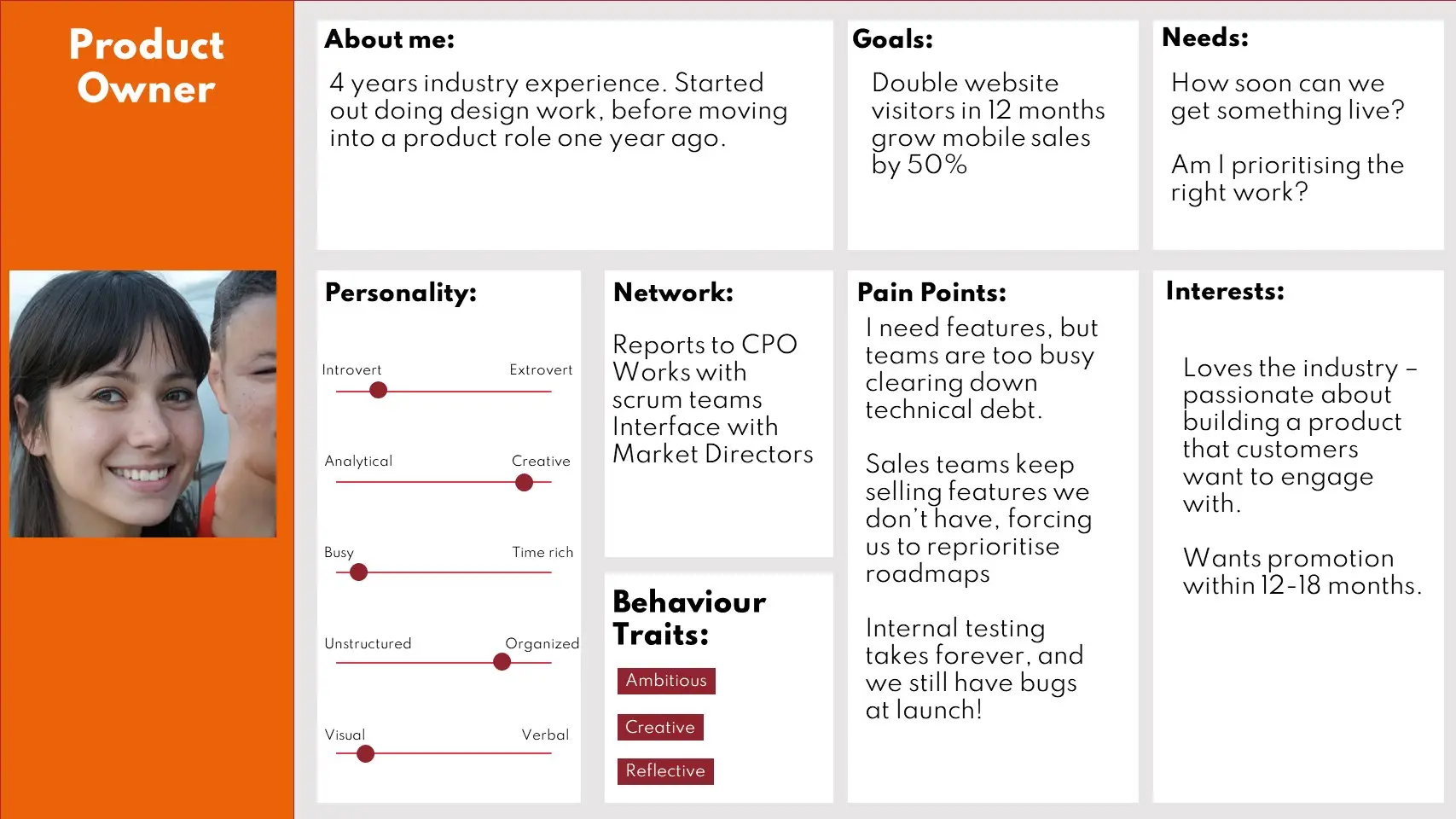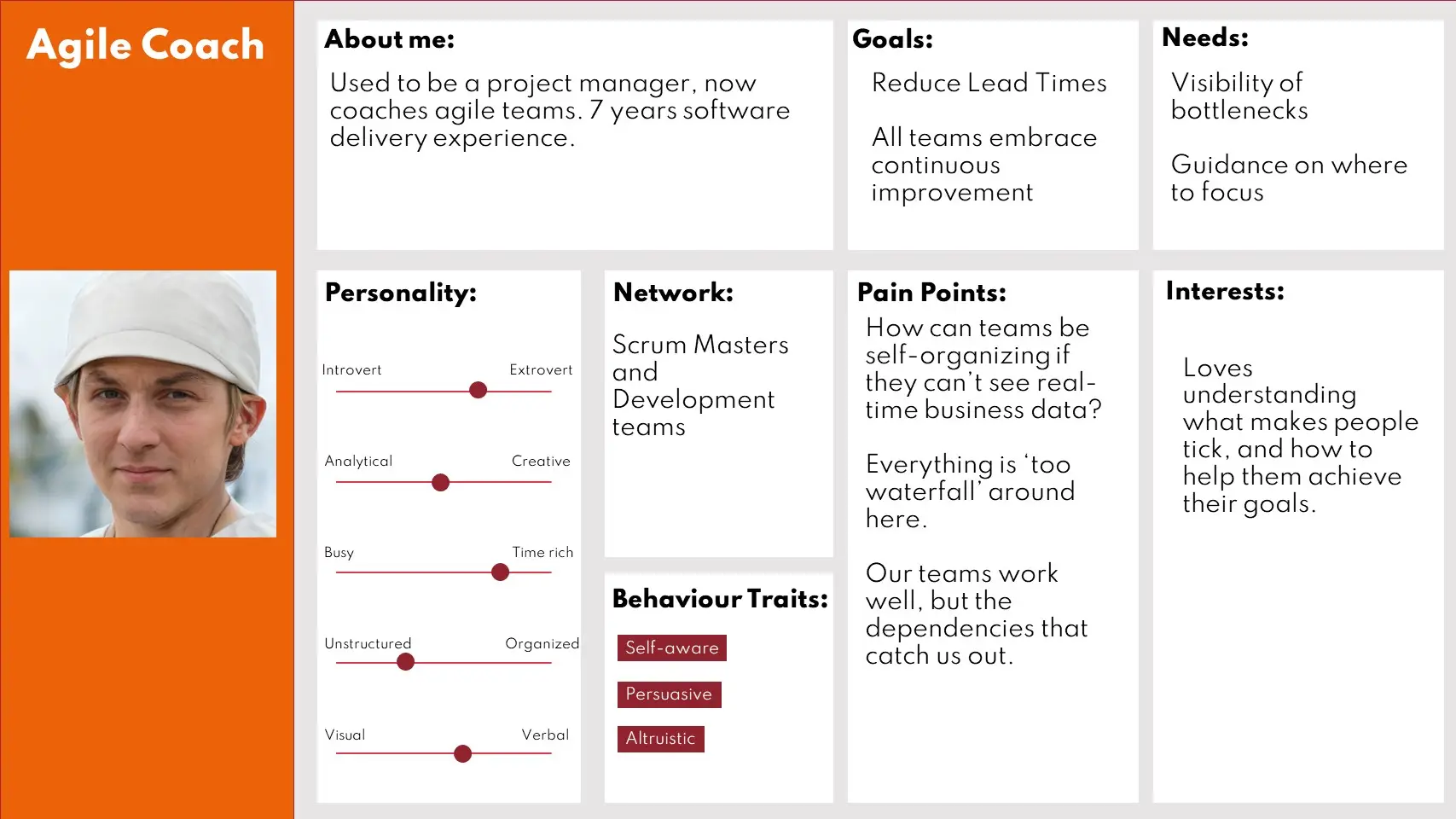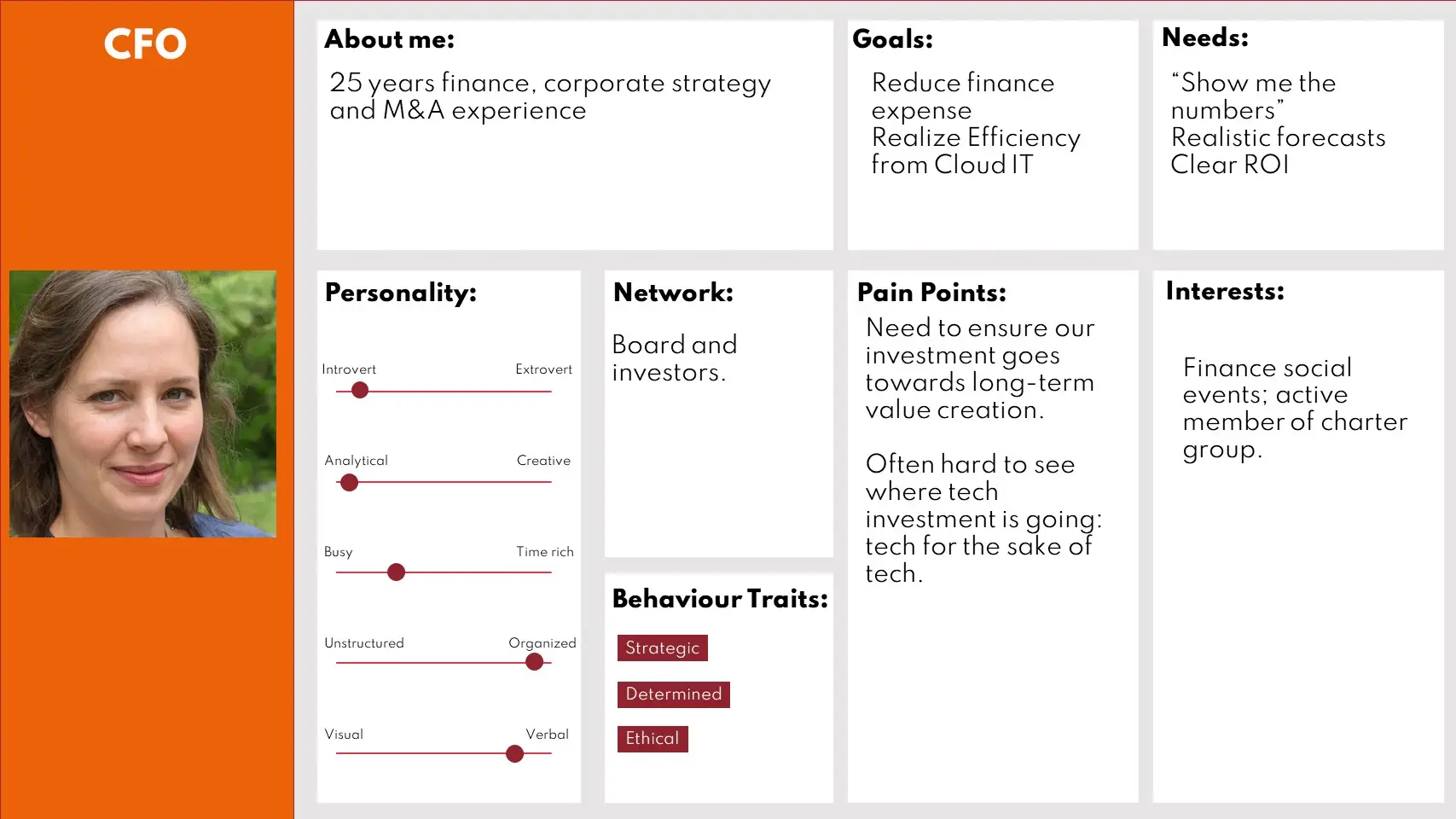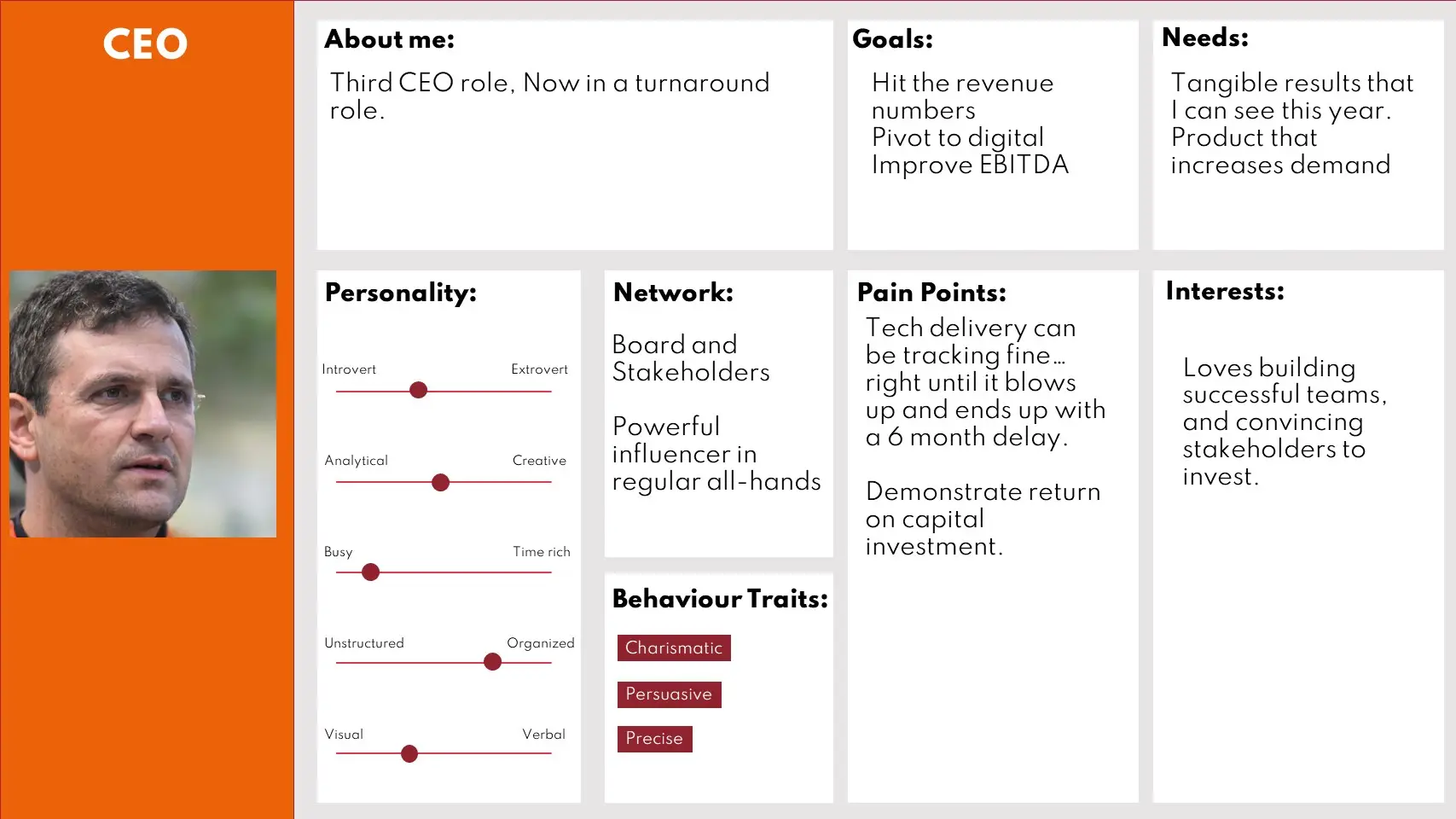User personas are semi-fictional characters that represent different areas of your target audience, user base or stakeholder group. Creating realistic personas can bring these groups to life and better understand and communicate with them. User personas help us understand how your target audience thinks, feels, and behaves. This information can then be used to make better decisions, design better services, and create a better customer experience. So what are the benefits of using user personas? Here are three key points to consider: First, user personas help product managers, project managers, and PMO Managers better understand their stakeholders – their customer base. Second, user personas help design better services by incorporating user feedback and preferences into the service design process. Third, user personas can help improve customer experience by understanding the customer’s needs and wants.
What is a user persona?
A user persona is a character created to represent a group of users with similar needs, goals, and behaviors. Think of it as a detailed profile that brings your target audience to life, helping your team understand and empathize with the people they are designing for. This character is based on evidence from real data and insights gathered from user research. By incorporating demographic information, goals, challenges, behaviors, and motivations, a user persona provides a comprehensive picture of your users. This tool is invaluable in user-centered design, marketing, and product development, as it ensures that the products and services you create truly meet the needs of your users.
Whether creating PMO Services or building a brand new business product, it is vital to understand who you are building for. This audience can be hard to visualize. After all, a Project Office may serve hundreds of people. And a new application may be used by thousands. So how do you ensure you are building the right things and providing what people need? User personas are a great way to understand better and target your efforts.
By representing your product or service users in a user persona, you can better understand their needs and wants. This information can create relevant, engaging and compelling content for your audience. By building different personas, you can better understand the different types of users that use your product or service. This can help you create better products and services that meet the needs of everyone.
Example of a Product Owner User Persona
Here’s an example user persona for a Product Owner. The individual is fictional: personas don’t represent a specific person. Instead, they are an amalgam – a character designed to represent one or more stakeholder groups or user types. A persona contains ideas about what drives the person, their interests, and what they are likely to care about. It is common to give them real names to bring a persona to life further. What name would you give to our Product Owner?

Benefits of using user personas
Using user personas offers several significant benefits that can transform the way your team works:
Improved User Experience: By understanding the needs and goals of your users, your team can design services that meet their expectations, resulting in a more satisfying user experience.
Increased Empathy: User personas help your team put themselves in the users’ shoes, fostering a deeper understanding of their challenges and motivations. This empathy is crucial for creating solutions that resonate with your audience.
Better Decision-Making: With user personas, your team has a framework for making design and product decisions based on actual user needs rather than assumptions. This leads to more effective and user-friendly outcomes.
Enhanced Collaboration: User personas can be shared across teams and stakeholders, ensuring everyone is on the same page and working towards the same goals. This alignment is key to successful project execution.
How do you create user personas?
There are eight steps to creating user personas:
- Gather data
- Segment your audience/stakeholders
- Determine the problems you are solving
- Personality traits
- Needs and Interests
- Pain Points
- Make it real!
- Share your personas with the team
1: Gather Data
The first step should be to gather data. For Product Managers, this means looking at your existing customers and understanding who is buying. For Project and PMO Analysts, this means conducting stakeholder analysis. Using real data at this stage is essential, as this is what you will base your personas on. It may be tempting to jump to the later stages, but in doing so, your risk the resulting persona being a fantasy character who fails to represent any of your ‘real life’ stakeholders.
2: Segment your audience/stakeholders
There are many ways to segment your data. For example, internally in an organization, you may segment people by their department. Or, if you are marketing a product, you may decide to use other characteristics such as whether buyers have children. Here are some standard segmentation options that can be considered in projects and PMOs:
- Generally in favour of the project? Or against it?
- Directly affected by the upcoming change, or not?
- Budget holder or budget influencer?
- Seniority in the organization
- Are they able to help make your project a success?
- Do they need to provide resources for the project to be a success?
3: Determine the problems you are solving
Whether PMO, project or product, chances are you are solving problems. In our article on modern project management, the organization’s problem was being a physical store in an increasingly digital world. When Sarah, the CIO, decided to hire a Project Manager, one of the problems she was solving was resistance to change and inertia. By understanding the problems you are solving for people, you build empathy. And empathy helps you better understand how you can help deliver what people need.
4: Personality Traits
We want to make our user personas as real as we can. Have you ever watched a movie and been frustrated that some characters simply lacked depth? We need to go deeper to get the most out of our personas. For example, take a look at the persona below of an Agile Coach. We flesh out some background about our Agile Coach based on what we know of the real Agile Coaches in our target audience. For example, the About Me section explains how our persona used to be a project manager and now coaches agile teams.
But we can go deeper still, as you can see in the Personality section of our user persona template. Is our Persona Introvert/ Extrovert? Analytical/ Creative? Busy or Time Rich? Do they prefer visual communication or verbal? All this information helps us build a picture of who we are trying to help and how best we can do so.

5: Needs and Interests
Understanding what makes your stakeholders tick is essential. Our Product Owner further up this article needs to know how quickly they can get things live. Our Agile Coach needs better visibility of bottlenecks. Developing this insight and capturing it in your persona allows you to understand where to channel your efforts.
6: Pain Points
We already have a good understanding of our persona, but let’s look at their current pain points. The best way to gather these is by having honest conversations with stakeholders or end-users.
7: Make it Real!
Now that you have fleshed out a persona representing a segment of your audience or stakeholders, it’s time to make it real! Add a photo to your persona and give them a name. Doing this may seem silly, but as humans, it is easier to empathize with a persona when we make it real.
8: Share your new personas with the team
Once you have your personas, make sure you share them. For example, if you work on a project, share them with the project team to help them understand who they are delivering for. If you are a product manager, share them with your marketing and PR teams so they can better plan content. And if you work in the PMO, you can use them to decide which services to offer and how best to support the business.
How to use user personas in your project or product management
Product management is all about meeting the needs of your target market. User personas are a great way to do just that. By understanding who your users are and how they interact with your product, you can design better products that meet their needs. To get started, you’ll need to build user personas using the eight steps above – remembering to begin with accurate data. Once you have this information, designing better and more user-friendly products will be much easier.
Personas are often used in the same way on projects as part of discovery and requirements gathering. But personas are also highly valuable as a tool for understanding stakeholders and managing project communications.
How to Apply User Personas in a PMO Setting
Once you’ve developed your personas, the next step is integrating them into PMO governance and decision-making. Here are some practical ways to apply them:
- Tailor Project Reporting: Instead of a single standard report, develop different report formats based on stakeholder personas. Some personas may require detailed risk logs, while others may only need top-level summaries.
- Improve Stakeholder Communication: Personas help refine messaging for different audiences, ensuring that status updates, steering committee meetings, and project communications are aligned with how different personas consume and act on information.
- Refine Training and Support: If the PMO is rolling out a new PPM tool or governance framework, different personas may require tailored training materials, FAQs, or onboarding sessions that match their needs.
- Drive Portfolio Prioritization: Understanding different stakeholder needs helps the PMO align portfolio decisions with organizational priorities by ensuring business cases and project justifications are framed in ways that resonate with different persona groups.
By integrating user personas into PMO practices, organizations can move beyond rigid frameworks and create governance models that truly support project success while minimizing friction.
User Personas in the PMO
The PMOs acts like a catalyst for organizations. But PMO teams are also cost centres and have finite resources. In short, they have to focus on the areas where they can deliver the most value to the organization in the most effective way possible. Personas can help ensure the PMO provides the right services to the business, but also the right metrics.
Using Personas in the PMO can help you provide the right services to the business
Persona development is a crucial step in designing or improving any product. So why are we advocating their use in the PMO? It is because by understanding your stakeholders’ problems, you can come up with better solutions and provide the right services to them quickly and easily. There are many types of PMO, and they all offer different services to the organizations they operate within. Selecting the right services and regular reviews of the service catalogue are essential. Processes should be purged regularly to ensure the services align with the needs of the business. By creating and maintaining personas for stakeholder groups, it is easy to understand the needs and pain points of the company and craft services to meet those needs.
In our example persona below, we can see that the CFO needs realistic forecasts and has concerns about technology being used just for the sake of it. It is clear how the insight into this user persona can be used to identify the right services and data/ reports to support the CFO with decision making.

Applying User Personas in the PMO can help you provide the right metrics

Conclusion
User personas are essential tools that can help you better understand your target audience and design more engaging and effective services. By understanding the different needs, wants, and motivations of your audience and stakeholders, you can channel limited resources to where they matter most. The eight-step process to create a user persona is straightforward yet incredibly powerful. By creating multiple personas, you build a picture of the community you serve and generate rich insight into your segmented audience’s goals, personalities and pain points.